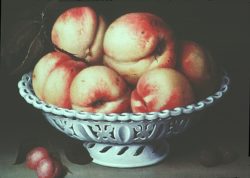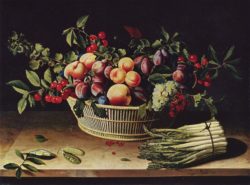- Peaches in a pierced white faience basket, Fede Galicia, 1578-1630
- Still life with Cherries, Cheese and Artichoke, Clara Peeters, 1615
- Fruit basket with Asparagus, Louise Moillon, 1630
Thus the question of women’s equality—in art as in any other realm—devolves not upon the relative benevolence or ill-will of individual men, nor the self-confidence or abjectness of individual women, but rather on the very nature of our institutional structures themselves and the view of reality which they impose on the human beings who are part of them. (Nochlin, 1971)
“The art market is not sexist,” Mr. Sewell said. “The likes of Bridget Riley and Louise Bourgeois are of the second and third rank. There has never been a first-rank woman artist.
“Only men are capable of aesthetic greatness. Women make up 50 per cent or more of classes at art school. Yet they fade away in their late 20s or 30s. Maybe it’s something to do with bearing children.” (Johnson, 2008)
An audit of the art world shows that every artist in the top 100 auction sales last year was a man, and just 8% of public art in central London was created by women. (Cochrane, 2013)
Perhaps I was naïve to think that in the 21st Century things had moved on for women artists but it seems that progress has actually been pretty slow. On the one hand it seems that there are more opportunities but on the other women are still underrepresented in the major institutions.
Delving into the world of historical Vanitas still life has been fascinating and has prompted this reflection on the position of women in art. I have some familiarity with art history and was aware that most of the artists presented as ‘great’ are men. What I am ashamed to say I wasn’t aware of was some of the women I came across in relation to the tradition of still life painting. Looking at some of the books on still life painting I have used for research for assignment five it would seem I am not the only one!
I am now happy to be acquainted with Fede Galizia, Clara Peeters, Louise Moillon, Rachel Ruysch, Marie Louise Elizabeth Vigee-LeBrun, Maria van Oosterwijck and Ann Vallayer Coster; 17th and 18th Century artists whose work appears to have been prolific and successful. I didn’t necessarily set out to consider the gendered nature of artworks and the artworld, to a certain extent it found me. What most intrigued me was the fact that there were a number of accomplished women still life painters because for the most part it was a form of art they were ‘allowed’ to participate in. It seems that between the Renaissance and the 20th Century, women were not permitted to participate in life drawing which excluded them from the academies and the major art institutions. They were relegated to what was regarded as the lower genre of still life, something more seemly for their gender.
Bryson (1990) argues that because of its low status Still Life is a genre that has been under-theorised, this certainly seems to be the case in relation to women in the field. In looking at the early works of the 17th and 18th Century women I was struck by how familiar they seem and that these objects and forms gave me a way of connecting with them.
The repeated shapes of the things in still life have been decided by consensus over many eras, and feel ‘right’ for the job. As such they create a cultural field far larger than any single individual, or even any particular generation: those addressed by these ancient and familiar forms are only the present members of a cultural family whose roots travel back into a vast preceding cultural community, which is in solidarity with each of the generations behind and ahead.(Bryson, 1990: 138)
In a small way I wanted my assignment to reach back and respect these women and flow forward into the future of the genre.
References and citations
BRYSON, N. 1990. Looking at the Overlooked: Four essays on still life painting, London, Reaktion Books Ltd.
COCHRANE, K. 2013. Women in art: why are all the ‘great’ artists men? Available: https://www.theguardian.com/lifeandstyle/the-womens-blog-with-jane-martinson/2013/may/24/women-art-great-artists-men [Accessed 18th June 2016].
JOHNSON, A. 2008. There’s never been a great woman artist. Available: http://www.independent.co.uk/arts-entertainment/art/features/theres-never-been-a-great-woman-artist-860865.html [Accessed 18th June 2016].
NOCHLIN, L. 1971. Why have there been no great women artists? Available: http://www.artnews.com/2015/05/30/why-have-there-been-no-great-women-artists/ [Accessed 20th June 2016].
























